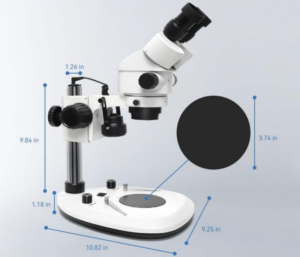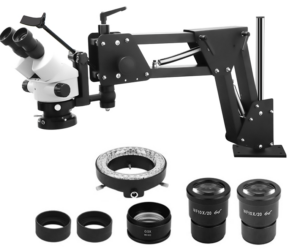As far as microscopes on the market are concerned, there are two types of microscopes that are relatively common, one is the stereo microscope and the other is the compound optical microscope. Although both microscopes are essential tools used by professionals to do research, there is a big difference between them. In today’s article, I’ll introduce you to what a stereo microscope is and what its components are, as well as what the different categories of stereo microscopes are and what they are used for.
What is a stereo microscope?
In a nutshell, a stereo microscope is a type of optical microscope that allows the observer to see a three-dimensional image from inside the lens of the microscope. The reason we can see three-dimensional images is because the components of a stereo microscope are slightly different from those of a compound optical microscope on a platform. A stereo microscope contains separate objectives and eyepieces and has two separate optical paths. The observer’s left and right eyes will observe at slightly different angles, and the final image presented will be three-dimensional.
What are the components of a stereo microscope?
- Eyepieces: Eyepieces are the lenses that you use to look at an object. If you differentiate stereo microscopes based on the number of eyepieces, you can categorize stereo microscopes into monocular, binocular, and trinocular microscopes. Generally speaking, the overall performance of a binocular microscope is better than that of a monocular microscope. A trinocular microscope is based on a binocular microscope with a camera attached directly to the microscope. This camera can be used to take pictures or videos, and there are also images on the camera that can be transferred to an external device in real time. The advantage of the camera is that you can always view the previous imaging of the microscope force. Also, more details are observed when the images are placed on an external display.
- Objective Lens: The objective lens is an auxiliary lens that allows you to adjust the actual magnification of the microscope. A stereo microscope will be equipped with several different objective lenses, and you can adjust the magnification by rotating the objective dial.
- Zoom Knob:The zoom knob is also called the zoom knob. As mentioned above, the objective lens is able to adjust the magnification of the microscope. However, the objective lens can only make an approximate adjustment, while the zoom knob can make a more detailed adjustment.
- Light source: Stereo microscopes have two separate light paths, which is why they are able to see stereoscopic images. The light source of a stereo microscope can be categorized into an upper illuminated light source and a lower illuminated light source. The combination of the two light sources ensures that the observer is able to view the object against a dark background or against a bright background.
How does a stereo microscope work?
Stereo microscopes observe objects mainly with the help of light reflected from the objects. Since the magnification of a stereo microscope is not very high, it is more suitable for observing some opaque objects, or some objects that are thicker in themselves.
You can also go out and purchase additional auxiliary lenses at your own expense if needed, which will increase the magnification of your stereo microscope.
Specifically, stereo microscopes are better suited for opaque objects. This includes coins, fossils or some mineral specimens. Some higher-end microscopes can also be used to observe circuit boards or electronic components.
Types of stereo microscopes and their uses
Stereo microscopes can be broadly categorized into fixed magnification microscopes, stereo zoom microscopes, digital stereo microscopes, handheld microscopes, and gemstone microscopes.
- Fixed Magnification Microscopes: The so-called fixed magnification microscopes are microscopes where the magnification can be adjusted with a rotating objective lens. The range of magnification of these microscopes has been fixed. People for whom fixed magnification microscopes are suitable include beginners, children, etc.
- Stereo Zoom Microscope: Although a stereo zoom microscope sounds similar to the fixed magnification microscope mentioned above, there are some differences. A stereo zoom microscope has a zoom knob that allows you to adjust the magnification. You can manually adjust the magnification of the microscope until the final image is what you want. Stereo zoom microscopes are designed for some professionals, such as scientists, or microscopists.
- Digital Stereo Microscope: A digital stereo microscope is an extra screen compared to an ordinary microscope. Users can observe the object imaging through the screen instead of directly observing the object through the microscope’s eyepiece. And many digital stereo microscope has digital zoom function, can more clearly observe the details of the object.
- Handheld microscopes: Handheld microscopes are more portable than traditional microscopes because their design will be more minimalist. However, there is no way to compare the professionalism of handheld microscopes with those professional microscopes. The main purpose of a handheld microscope is to inspect some industrial parts. Handheld microscopes are ideal for children and novices because of their compact design.
- Gemstone Microscope: A gemstone microscope is a type of microscope that is specialized for observing gemstones. Generally speaking, jewelry experts use specialized gemstone microscopes to identify the authenticity of gemstones or to observe the quality of gemstones.

Article Summary
In a word, stereo microscope has two independent light paths and can present three-dimensional images, which is more suitable for observing some opaque objects. There are also many types of stereo microscopes, if you have the idea of buying a stereo microscope, you can use this article as a reference.






